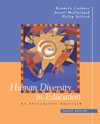 |  Human Diversity in Education: An Integrative Approach, 4/e Kenneth H. Cushner,
Kent State University, Kent
Averil McClelland,
Kent State University, Kent
Philip Safford,
Case Western Reserve University
Developing Learning Communities: Language and Learning Style
Chapter OverviewClassrooms that are learning communities seem to be at the heart of effective teaching and learning in the twenty-first century. Of particular importance in this regard is attentiveness to the language or languages of students and teachers and to the ways in which all individuals naturally approach teaching and learning. Clearly, language structures the very thoughts and ideas we have as human beings. Not only do we have particular vocabularies that have meaning for us, but we also structure our sentences and pronounce our words in particular ways that we have learned as part of our primary socialization as young children and that therefore seem comfortable and "right" to us. In classrooms where children of diverse backgrounds attempt to learn a proscribed curriculum, teachers must pay attention to the students' linguistic backgrounds so that they can be certain that all children are effectively understanding and participating in all learning activities. Teachers who are working with children whose first language is not English must remember that each child's language is an integral part of that child's personhood, and must make every attempt to regard that personhood with respect. Both the proponents and opponents of bilingual education want children to learn; both disagree—sometimes profoundly—on the best means (and the best language) to achieve that goal. Because of the history of the bilingual education debate and because of the increasing interconnectedness of today's world, teachers must be clear in their own minds about the relative merits of bilingual education. |
|



 2003 McGraw-Hill Higher Education
2003 McGraw-Hill Higher Education